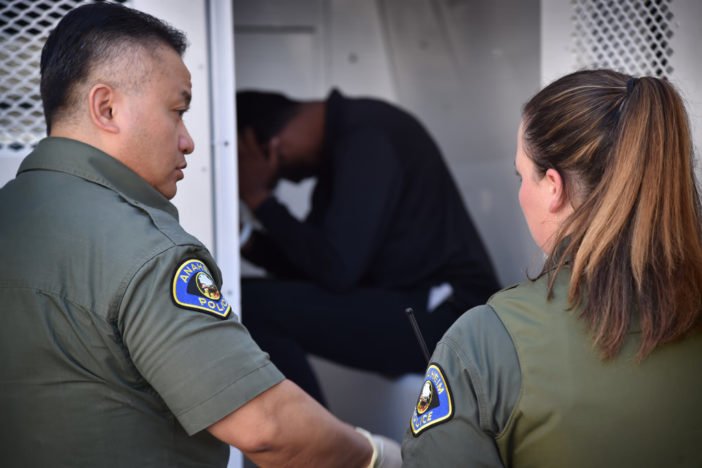Come to Orange County and work for me, the pimp urged the young mother in South Dakota.
Reaching out to her on social media, he sent her pictures of mansions and luxury cars, and promised her that her life — and that of her 4-year-old son — would improve if she agreed to be his sex worker.
She did, but things didn’t turn out to be so sunny for the pimp, Johnny Lee Guyton.
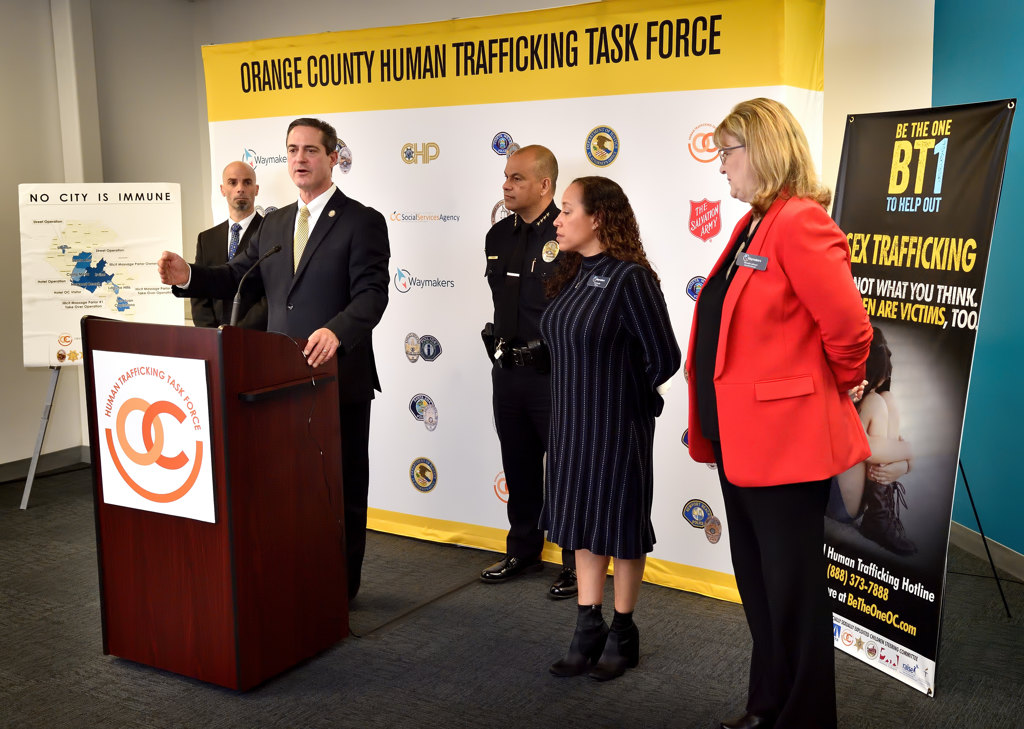
Orange County District Attorney Todd Spitzer participates in a news conference on Thursday, Feb. 21 that detailed the 2019 Human Trafficking Victim Report produced by Orange County Human Trafficking Task Force (OCHTTF). Behind Spitzer are, from left, Scott Burdick, deputy director of the Department of Children and Family Services for the Orange County Social Services Agency; Anaheim Police Chief Jorge Cisneros; Waymakers Director of Victim Assistance Programs Lita Mercado; and Ronnetta Johnson, executive director of Waymakers. Photo by Steven Georges/Behind the Badge
On May 17, 2016, an O.C. jury convicted Guyton of human trafficking. He was sentenced to 14 years in state prison for luring the woman into a lifestyle that netted him between $30,000 and $50,000, but left his victim in a cycle of misery in which she couldn’t see her son unless she met her daily quota of $1,000, according to court rulings.
Guyton is emblematic of the criminals who prey on vulnerable women (and some men), nearly a third of them minors. They recruit them to engage in commercial sex, often seven days a week, throughout O.C.
These modern-day sex slaves service “Johns” in rooms ranging from darkened hideaways in massage parlors in lower-income neighborhoods to upscale coastal hotel suites, law enforcement officials say.

Anaheim Police Chief Jorge Cisneros speaks at the news conference Thursday, Feb. 21 at Waymakers headquarters in Santa Ana.
Photo by Steven Georges/Behind the Badge
Thursday, at a news conference that detailed a 2019 victim report produced by the Orange County Human Trafficking Task Force (OCHTTF), District Attorney Todd Spitzer made an invitation of a different kind.
“If you’re involved in pimping or pandering or exploitation, come to our county,” Spitzer said at the news conference, held at Santa Ana-based Waymakers, a non-profit that is one of the OCHTTF partnering agencies.
“We want you here because we’re going to stalk you like you stalk your victims,” Spitzer said. “We’re going to stalk you like you stalk your prey. And the reason I want you to come here is because I’m confident that our law enforcement team will do what we’ve been successfully doing, which is sending you to prison for many, many years…We are not going to tolerate this is our county.
“I just want it to be abundantly clear and unequivocally clear that the Orange County District Attorney’s Office will fully prosecute you to the extent of the law.”
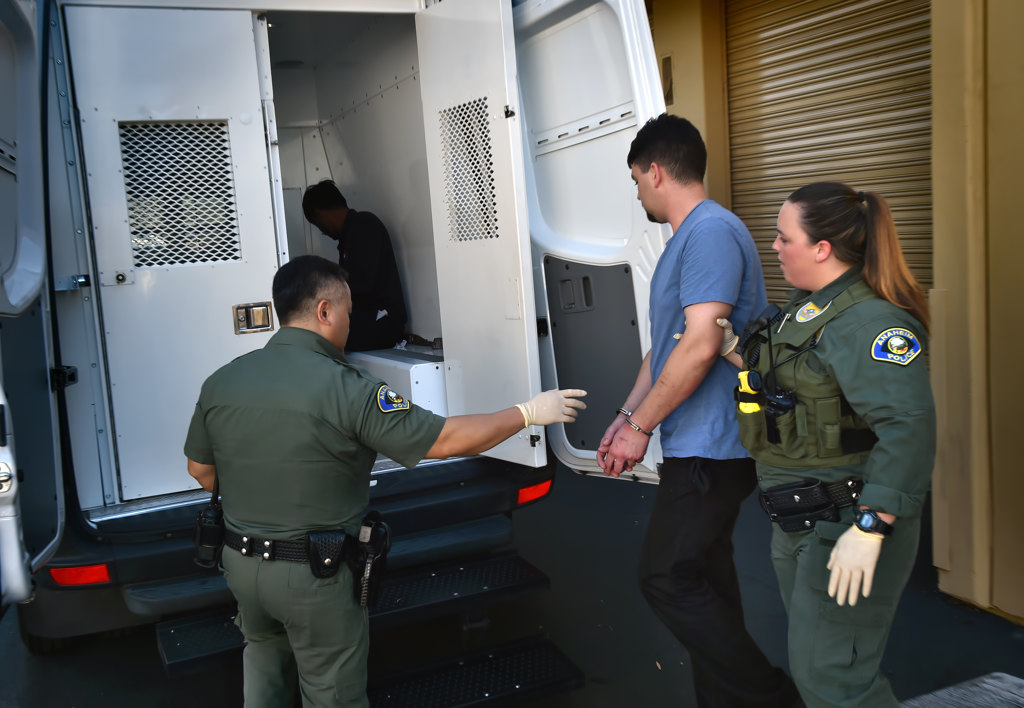
Anaheim PD Corrections Officers Melvin Miranda and Danielle Holt take a suspect to an Anaheim police transportation vehicle after he was arrested in a sex-purchaser sting operation in San Juan Capistrano in July 2018.
Photo by Steven Georges/Behind the Badge OC
The report, which covered the years 2017 and 2018, said collaboration between the dozen-plus agencies that participate on the OCHTTF, as well as public awareness ads on buses and other places urging people to “Be the One” to help fight human trafficking in O.C., has resulted in a paradigm shift in how victims are identified and supported.
Prior to 2017, nearly all referrals to the OCHTTF came directly from law enforcement personnel who identified victims in the field, said Lita Mercado, director of Victim Assistance Programs at Waymakers, the administrator of the task force that formerly was named Community Service Programs Inc.
In 2018, by contrast, 57 percent of referrals were received by sources other than law enforcement.
Mercado and other officials said the dramatic shift is a clear sign that the task force, formed in 2004, has been successful in generating increased awareness about the problem of human trafficking in O.C., which in turn is getting more victims off the street.
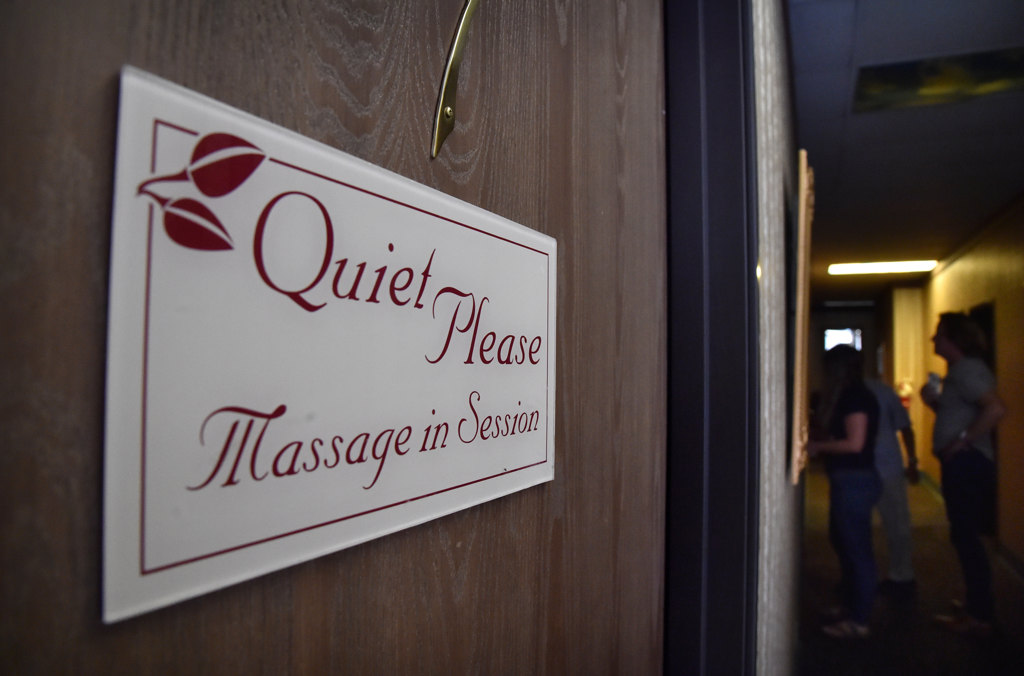
The interior of a San Juan Capistrano massage parlor used by the Orange County Human Trafficking Task Force in a sex-purchaser sting operation in July 2018.
Photo by Steven Georges/Behind the Badge OC
“Waymakers does not ask our clients a wide variety of questions just for data collection,” Mercado explained. “Rather, we meet the client where they are at, literally and figuratively, and we start the conversation where they want it to begin.”
The OCHTTF has become a model nationally and internationally in the fight against human trafficking, said Waymakers Executive Director Ronetta Johnson.
In 2017 and 2018, OCHTTF aided 415 victims of human trafficking in what it describes as a victim-centered and trauma-informed approach – a stark contrast to how those working in the sex trade were perceived in the past: as criminals.
“I’m so excited to be here because what I want you all to understand is how far we’ve come,” Spitzer said. “When I was a prosecutor in the 1990s, we used to go into North Court and the cage was full of women who we were prosecuting for prostitution … This collaboration is very meaningful, for all the entities that are involved. Why? Because we fundamentally changed how law enforcement sees women and some men who are involved in sex trafficking. That is so important, because instead of looking at them as criminals, we are so much more educated and sophisticated that we actually know they are victims.”
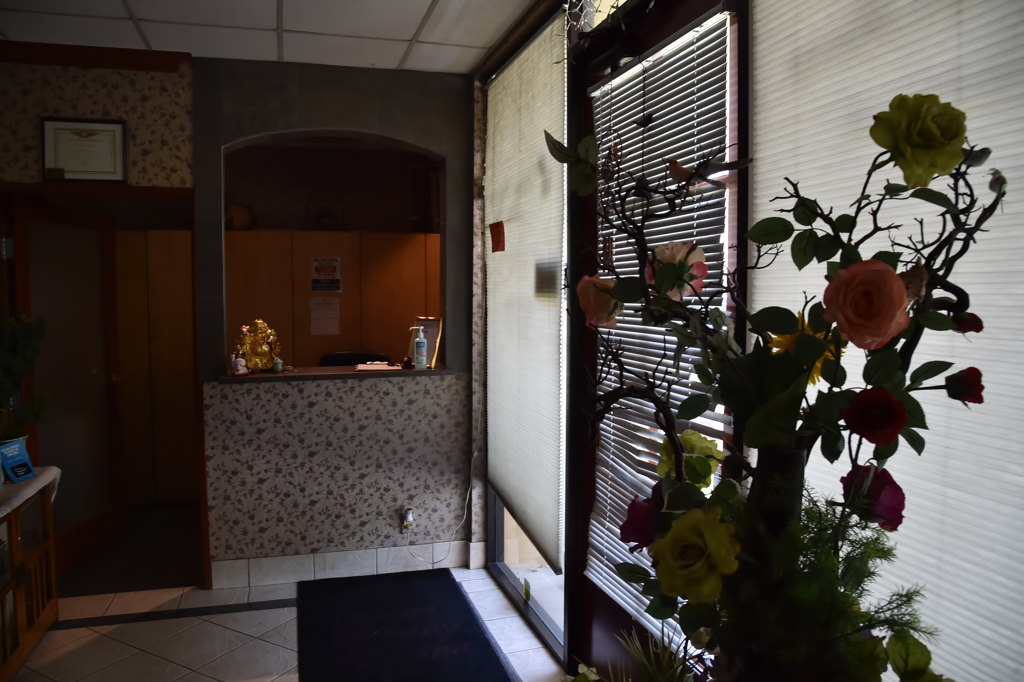
The front lobby of the San Juan Capistrano massage parlor used in a sex-purchaser sting operation in July 2018. Photo by Steven Georges/Behind the Badge OC
Nearly a third of the 415 victims of human trafficking in 2017-18 were under age 18, and 87 percent of them were sex trafficking victims, according to the report. The remaining 48 were victims of labor trafficking.
Mercado pointed out that “human trafficking” is not a euphemism for prostitution.
“Human trafficking is modern-day slavery,” she said. “It is when someone uses force, fraud or coercion to obtain some type of labor or commercial sex act….A closer look at commercial sex reveals that these are torn-down victims of a complex criminal activity.”
Mercado said Orange County is a destination for human traffickers because perpetrators have told authorities they can make more money here than in surrounding counties.
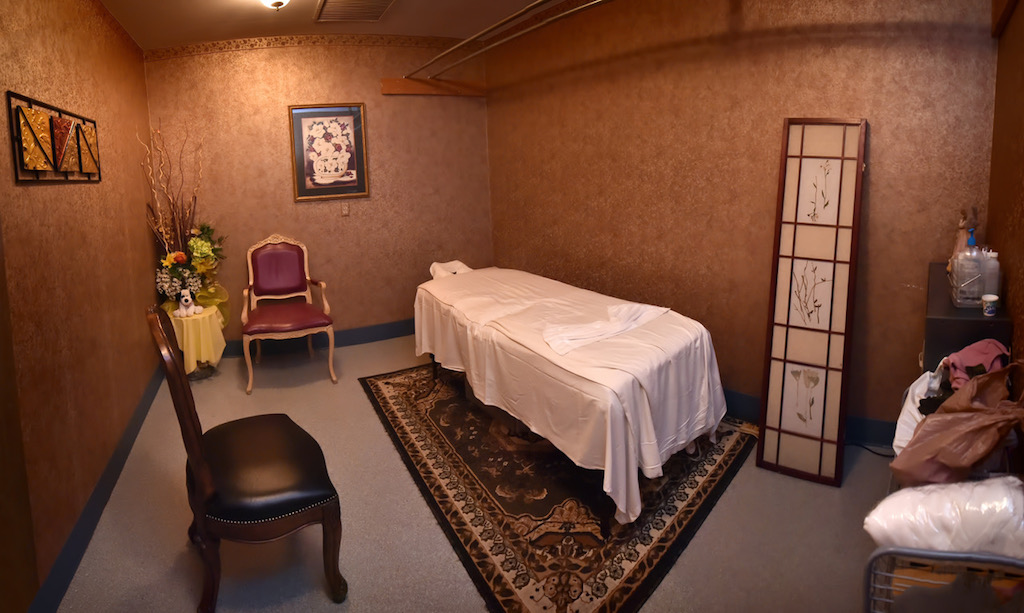
A massage room, one of many, that was used in a sex-purchaser sting operation in July 2018 in San Juan Capistrano.
Photo by Steven Georges/Behind the Badge OC
Other key findings in the 2019 Human Trafficking Victim Report:
- 83 percent of victims were U.S. citizens
- 93 percent of victims were females
- Nearly a third of victims had been identified in prior years as victims of human trafficking in Orange County.
- Seventy-one percent of Commercially Sexually Exploited Children (CSEC) victims already were involved in the juvenile delinquency or child dependency system when they were identified as victims
- There were 169 convictions of people on charges involving human trafficking, pimping, and pandering in 2017-18. Between 2012 and 2018, a total of 504 cases of human trafficking, pimping, and pandering were prosecuted in Orange County.
The Anaheim Police Department is a lead agency involved in OCHTTF.
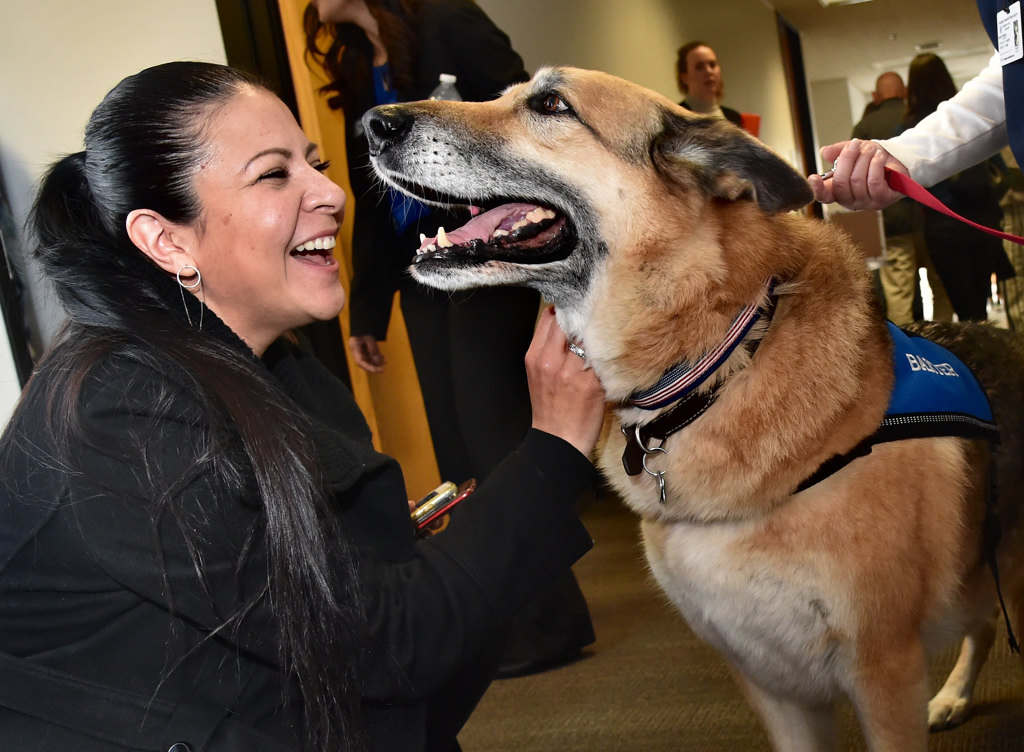
Patty Scrazia, a victim advocate with Waymakers, visits Baxter, a therapy dog with the Orange County Human Trafficking Task Force.
Photo by Steven Georges/Behind the Badge
Speaking at the news conference, APD Chief of Police Jorge Cisneros, co-chair of OCHTTF, said that about 80 percent of human traffickers and their victims in Orange County come here from other areas of the state and country.
“Over the past several years, law enforcement has had to shift our paradigm as to how we view victims of trafficking and human trafficking,” Cisneros said. “That shift has resulted in a number of improvements to the service we provide to survivors of these horrific crimes.”
The OCHTTF also has opened a shelter for victims of human trafficking to help them as they enter the recovery phase, Cisneros said. In prior years, victims were given vouchers to motels.
Officials at the news conference noted that battling the demand side of the equation is critical to fighting human trafficking in O.C. In July 2018, OCHTTF conducted a half-dozen sex-purchaser sting operations to catch “Johns” in the act of soliciting sex acts from undercover officers, including an operation at a massage parlor in San Juan Capsitrano known as a haven for commercial sex.
More similar stings are planned for this year, said APD Sgt. Juan Revelas, who has run the law enforcement component of OCHTTF since 2014.
The OCHTTF also went after the demand side of the problem, Cisneros noted, by working with faith-based communities to raise education and awareness at presentations to men’s groups. The chief also noted that a video also was played at John Wayne Airport to warn visitors that O.C. doesn’t tolerate the commercial sex trade.

Orange County District Attorney Todd Spitzer at the news conference on the state of human trafficking in Orange County.
Photo by Steven Georges/Behind the Badge
Orange County Assistant District Attorney Ted Burnett also noted that booking photos of sex purchasers who have been arrested are posted on an OCDA website to deter would-be “Johns.”
The OCHTTF is a multidisciplinary anti-human trafficking effort of over 60 agencies including law enforcement, victim service providers, nonprofit organizations, faith-based organizations, government agencies and the community.
“The fight against human trafficking cannot be waged by one entity alone,” Johnson said.
For more information about OCHTTF and resources, visit ochumantrafficking.com. For more information about Waymakers, visit WaymakersOC.org
 Behind the Badge
Behind the Badge
